If you read my Top 10 Draft Tips piece, you got a preview of the method I have been using for many years in fantasy baseball. It's really less of a method or strategy, and more a state of mind. The Bullpen Method is a lifestyle!
I always speak about the importance of balance on a fantasy team. For your pitching staff, I find this even more important. You need steady, solid, balance and, to be frank with you, that is not possible with a bunch of starting pitchers on your roster. Sure, you can attack Wins and Strikeouts, but your ERA and WHIP have no chance at survival. There are like 10 starting pitchers in all of baseball that I would trust with my team's ERA and WHIP, and you want to fill your roster with them?
When your draft day arrives before the start of the 2020 MLB season (hopefully soon), I encourage you to try my bullpen method for roster construction.
Featured Promo: Want a free RotoBaller Premium Pass? Check out these sports betting promo offers from the top sportsbooks! All new sign-ups get a free bonus offer on their first deposit, and a free year of RotoBaller's Premium Pass for all sports ($450 value)! Sign Up Now!
Breaking down JB's Bullpen Method
In a standard league, I will roster ~12 pitchers. Of the 12 pitchers, I will have five SP. That means the other seven are Relief Pitchers - and I don't care if they are closers right now or not. For years, Dellin Betances and Andrew Miller were my anchors, then Josh Hader emerged, and every year a new crop of setup studs emerge like Giovanny Gallegos. This is the Bullpen mentality, realizing that Starting Pitchers are heavily overrated in fantasy and subsequently relief pitchers (especially setup men) are heavily underrated. Once you come to this epiphany, you can immediately take advantage of the common industry mistake and instantly witness improvement on your teams.
*Disclaimer - Please do not attempt this method in Points Leagues. Points leagues are made for heavy-volume starters and the elite closers. This method absolutely crushes Roto leagues, where balance is king - but also works in H2H leagues where you can easily beat your opponent in 3 of 5 pitching categories (5 of 5 if you are a talented SP streamer).
2019 Examples
Let's first look at some 2019 examples, shall we? Example 1 is the RotoBaller Expert Roto League.
I finished the season with 13 pitchers on the roster. As always, five of those were starters: Homer Bailey, Hyun-Jin Ryu, Ryan Yarbrough, Tyler Glasnow, and Dylan Bundy. Typically in a vacuum with that rotation, I should have had no business being in even the top half of the league's standings, right? What if I told you I won the league with over 100 roto points? Bullpen Method to the rescue!
Since I told you just five of my 13 pitchers were starters, that means the other eight were obviously relievers. The eight RP on my roster were:
- Seth Lugo (7 W, 6 SV, 104 K, 2.70 ERA, 0.90 WHIP)
- Emilio Pagan (4 W, 20 SV, 96 K, 2.31 ERA, 0.83 WHIP)
- Will Smith (6 W, 34 SV, 96 K, 2.76 ERA, 1.03 WHIP)
- Keone Kela (29.2 IP - 2 W, 1 SV, 33 K, 2.12 ERA, 1.01 WHIP)
- Brandon Workman (10 W, 16 SV, 104 K, 1.88 ERA, 1.03 WHIP)
- Julio Urias (4 W, 4 SV, 85 K, 2.49 ERA, 1.08 WHIP)
- Giovanny Gallegos (3 W, 1 SV, 93 K, 2.31 ERA, 0.81 WHIP)
- Drew Pomeranz (2nd half - 57 K, 1.96 ERA, 0.82 WHIP)
How hard do you think it was to draft this group of relievers last season? Extremely easy, and very cheap. All below 2.80 ERA and all below 1.09 WHIP. Sprinkle in all the saves you pick up along the way as they change roles in the bullpen and you've just won three of five pitching categories handily.
Let's look at another winning example from last year - this time in a H2H league. This time my five starters looked much better with Gerrit Cole, Clayton Kershaw, Charlie Morton, Robbie Ray, and Ryan Yarbrough. Again I went with 13 total pitchers, meaning once again I had eight relievers. Those eight relievers were:
- Alex Colome (4 W, 30 SV, 55 K, 2.80 ERA, 1.07 WHIP)
- Trevor May (5 W, 2 SV, 79 K, 2.94 ERA, 1.07 WHIP)
- Drew Pomeranz (2nd half - 57 K, 1.96 ERA, 0.82 WHIP)
- Chad Green (2nd Half - 55 K, 2.89 ERA, 0.96 WHIP)
- Taylor Rogers (2 W, 30 SV, 90 K, 2.61 ERA, 1.00 WHIP)
- Keone Kela (29.2 IP - 2 W, 1 SV, 33 K, 2.12 ERA, 1.01 WHIP)
- Ross Stripling (4 W, 93 K, 3.47 ERA, 1.15 WHIP)
- Julio Urias (4 W, 4 SV, 85 K, 2.49 ERA, 1.08 WHIP)
As you can see with the added boost I had at SP, and it being a H2H league, I cared even less about finding Saves and focused more on the extra K from my bullpen while still nailing down the ERA and WHIP categories on a weekly basis. This is why I said earlier that the Bullpen Method is more of a mentality than an actual black and white strategy - you can tweak it based on the league and your roster build. We will look at some of the different drafting techniques within the method a little later.
Building Franken-Aces with Relievers
The first question most people ask when they see my drafts is - "How can you win without drafting aces?" Well, there are two answers. First, draft the sleepers that become aces. Duh, right? Like the Roto league example above, I was able to get Ryu and Glasnow for very cheap and for chunks of the season they were bonafide aces. That certainly helps. But the second and most important answer is YOU BUILD THEM WITH RELIEVERS. Like Frankenstein, you can put together a stud ace with unwanted scraps you find on the waiver wire or late in the draft.
Let's do some building. Take Brandon Workman and Emilio Pagan from 2019. Both were for the most part undrafted in leagues, or at-best late stashes because Boston's bullpen situation was sketchy. So now we have our unwanted scrap parts. Now let's combine their end of season stats. We get 14 W, 200 K, 2.10 ERA, and 0.93 WHIP. Now let's compare. Clayton Kershaw finished 2019 with 16 W, 189 K, 3.03 ERA, and 1.04 WHIP. Our Franken-Ace easily has him beat.
But he was only SP11, so let's now look at the SP4, Zack Greinke. He finished 2019 with 18 W, 187 K, 2.93 ERA, and 0.98 WHIP. Franken-Ace still has the SP4 easily beat in three of the four "SP" categories. Oh, and don't forget Workman and Pagan combined for 36 Saves too. Franken-Ace is a five category monster that only took two relief pitchers to build, and I carry six of these relievers at a minimum meaning I can build at least three of these aces.
"But those are two breakout stud relievers that became closers. They are the exception." Fair enough. Let's try another Franken-Ace, this time without closers because closers are the best relievers right? Silly simpletons. Let's go with two setup men that I also owned multiple shares of last year: Seth Lugo and Giovanny Gallegos. So we have our new unwanted scrap parts. When we combine their end of season stats we get 10 W, 197 K, 2.51 ERA, and 0.86 WHIP. Now, let's look at Jack Flaherty who is being drafted in the second round of most drafts for 2020. He finished 2019 with 11 W, 231 K, 2.75 ERA, and 0.97 WHIP. This ace tied the Franken-Ace 2-2 in the four SP categories, but by only ONE win and 34 K, and again he loses in the Saves department to break the tie.
What the hell, let's do one more. This time let's do a second-half Franken-Ace because remember, the Bullpen Method is not solely a draft strategy. It is a mentality that is fluid and lasts the entire season. Relievers are like any other position in baseball, they have splits. They can start off cold and finish hot, and just as easily vice-versa. This is why I picked up Chad Green and Drew Pomeranz after rough starts to 2019. So we have our unwanted scraps. Let's say I put them together during the All-Star break to make a second-half Franken-Ace. Combine their second-half stats: 2 W, 112 K, 2.43 ERA, and 0.89 WHIP.
Next, let's look at one of the best 2019 second-half SP performers, Yu Darvish. Over the same timeframe, he earned 4 W, 118 K, 2.76 ERA, 0.81 WHIP. Bravo, Mr. Darvish, you defeated our second half Franken-Ace, but it was a very close fight and against two relievers that were way off standard league radars. The Green/Pomeranz combination was a lethal weapon down the fantasy playoff stretch last year and was a perfect mid-season pivot from first-half darlings such as John Gant. Fluidity. There is always a reliever on the waiver wire that has what you are looking for. Don't get wrapped up in names or roles, just current production.
Wasn't that fun? So we are not only making Franken-Aces out of late-round picks/ free agent pickups, but at the same time our offense is STACKED because while the rest of the league was wasting picks on their starting pitchers in the early rounds, we were grabbing the elite bats. That is the heart and soul of the Bullpen Method, and why it is so deadly. You are stacking your offensive categories and then winning/catching up on pitching categories on the back end without breaking a sweat.
JBullpen Method Drafting Strategies
As I have said numerous times already in this article, and will probably say a few more times - this is not a black and white strategy. You can't say "I drafted Blake Treinen and Edwin Diaz in 2019 because JB said relievers were better than starters and they both sucked so I lost." That's why it is more a state of mind, where names and roles don't matter. All you care about is numbers. If one guy isn't getting it done, move on, even if he is getting saves.
With that being said, I have noticed over the years that the drafting strategy, specifically how you handle starting pitchers and closers really doesn't matter with the Bullpen Method which is what makes it so cool. You can get five true aces as your starting pitchers, or you can get one ace and four mid-late round starters, or you can wait until round 10 to get your first starter. Names don't matter. Those five arms are there to get you IP, W, and K to keep you afloat in those categories while your bullpen does the rest.
I ran some mock drafts with the three main draft techniques to prove it and to also show you just how flexible you can be. Because the best drafting strategy is to always take what the league gives you. I broke down the drafts into three categories: Pitching Light, Pitching Heavy, and Don't Pay for Saves. Let's see how they looked.
I used FantasyPros for the mocks with 5x5 Roto categories, 28 roster spots, C, 1B, 2B, 3B, SS, CIF, MIF, OF x 5, UTIL x 2, P x 9, Bench x 5.
Pitching Light (1 x SP, 2 x RP in first 14 Rounds)
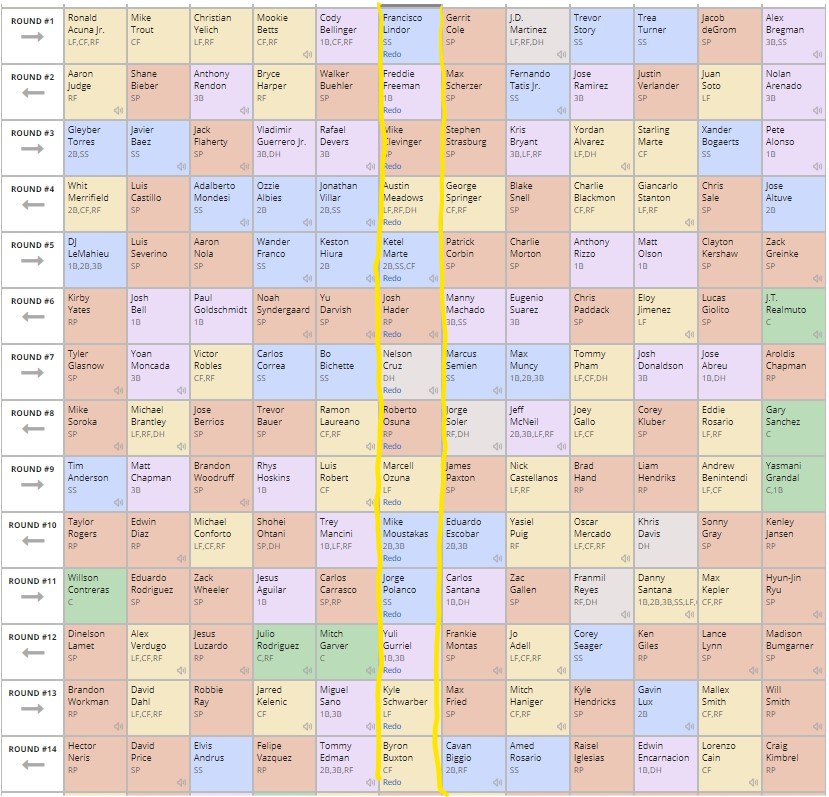

This draft technique is my favorite with the Bullpen Method. I get one true stud SP after a few elite bats, usually in the Mike Clevinger, Yu Darvish, Clayton Kershaw range of names. Then I grab some elite relievers that happen to fall into my lap for those elite ratios. But other than that, the first half of the draft is all about the bats. I can get basically whatever hitters I want and really blow the league away offensively. Then, hit the pitching fast and furious in the second half in usually an OCD-driven SP-RP-SP-RP pattern until I have filled my five-man rotation. Let's see how the projections look:

This is the prototypical league roto rankings layout for my teams. My offense is competing for the top spot in all categories because of the number of first-half picks on the stud hitters. Saves, ERA, and WHIP are locked in - despite only have three pitchers at round 14. That is the power of the Bullpen. Some successful SP-streaming throughout the season can vastly improve the W and K totals for some extra first-place padding, especially in daily-roster move leagues.
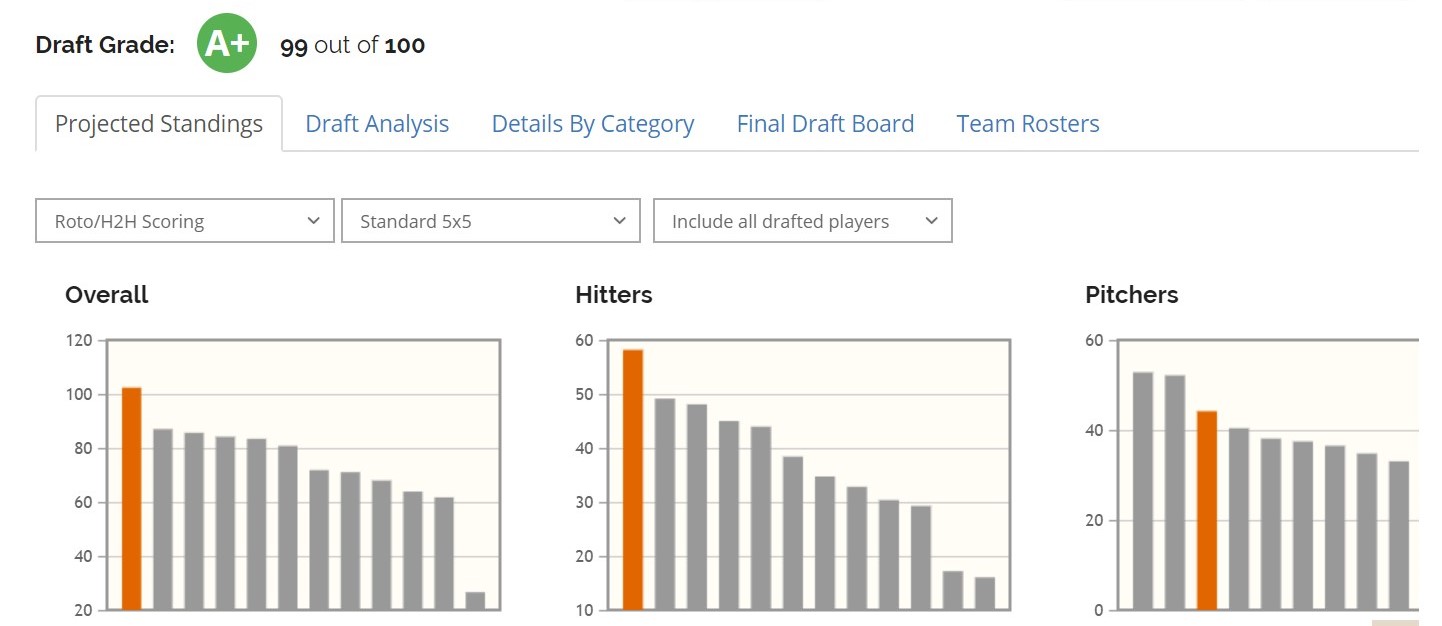
Pitching Heavy (5 x SP, 3 x RP in first 14 Rounds)
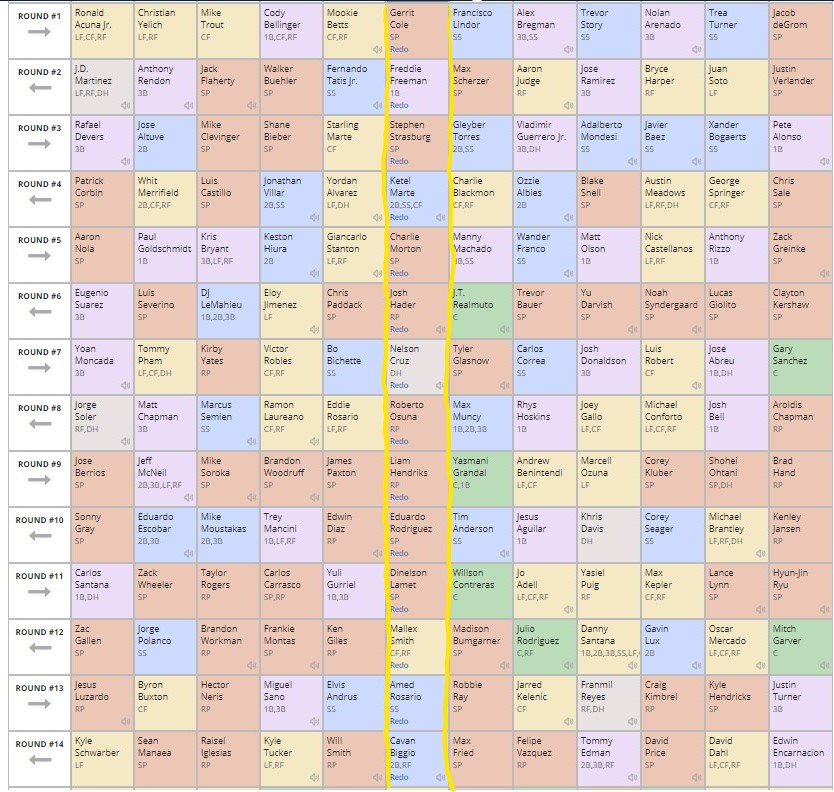

You will NEVER see me utilizing this strategy, and you will shortly see why. Going inverse from the last and most-preferred strategy of Pitching Light, we now go eight pitchers in the first half of the draft and attempt to build our offense with value bats in the second half while also sprinkling in our stud setup men.

***So obviously we expect the hitting categories to take a hit in this strategy where we focus on our pitchers early instead of loading up on bats. But the big shocker and the proof of Bullpen Method is the pitching categories. In this strategy, we drafted Gerrit Cole, Stephen Strasburg, and Charlie Morton along with some elite closers and the pitching projections look the exact same as our Pitching Light strategy where we only had ONE starting pitcher in the first 14 rounds.
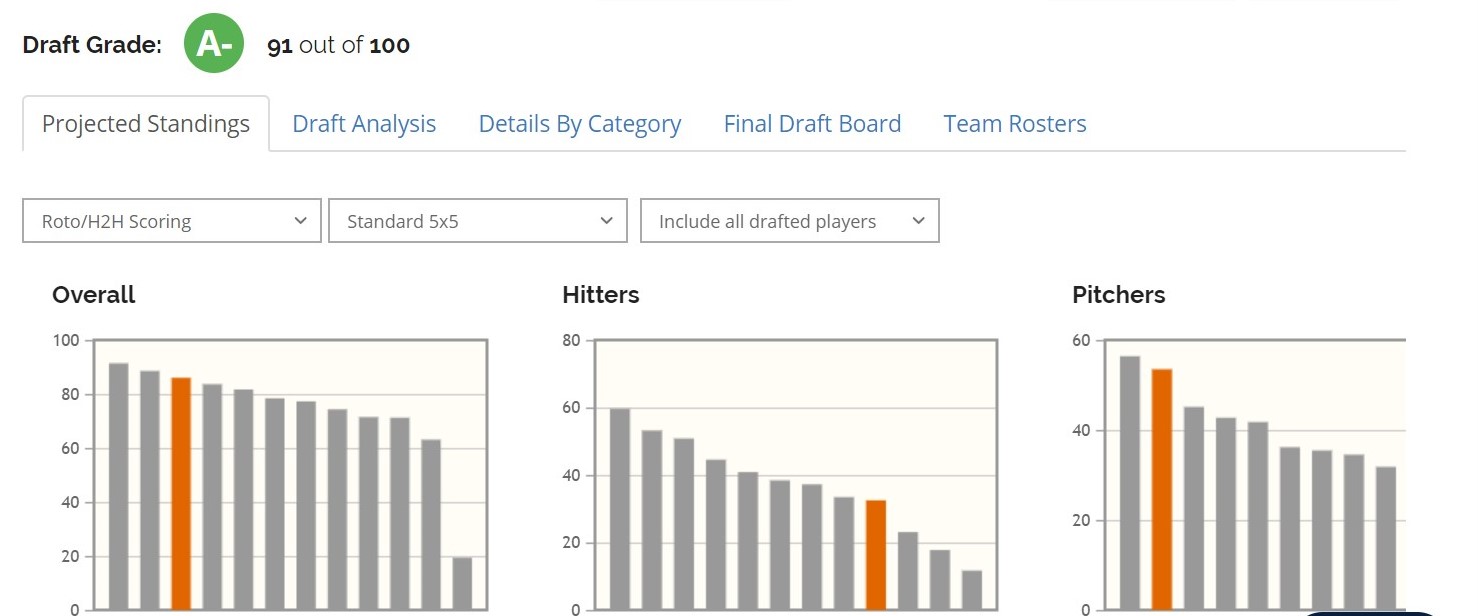
Don't Pay for Saves (5 x SP, 1 x RP in first 14 rounds)
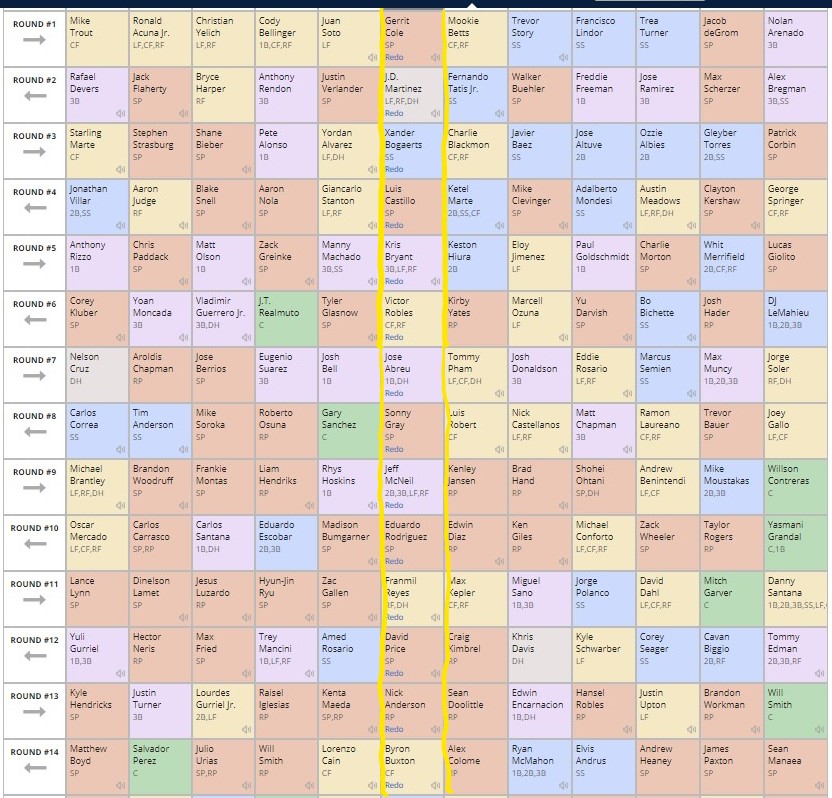
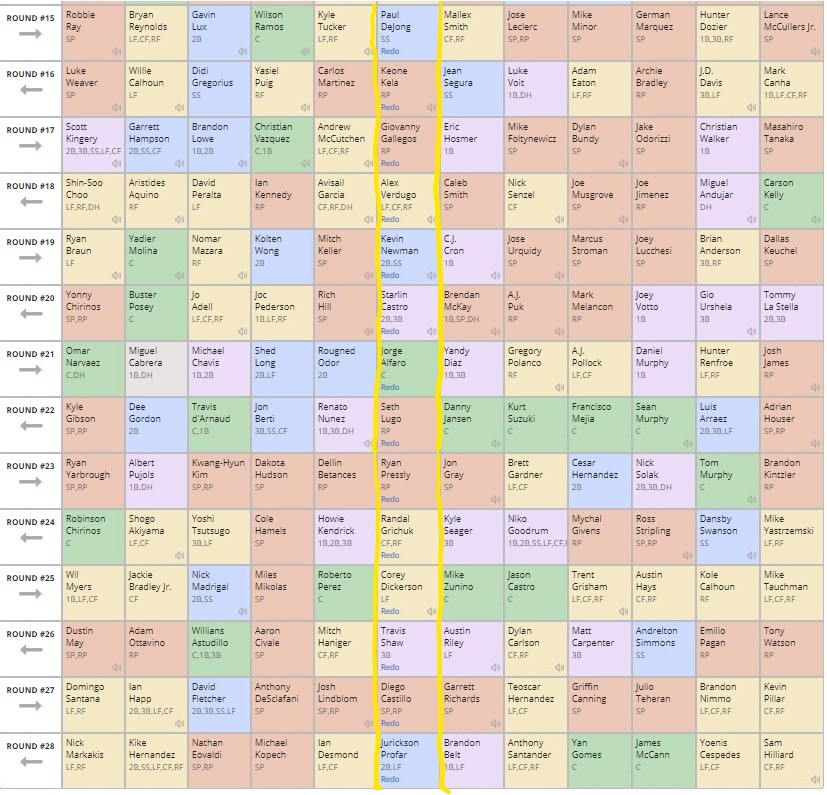
I may have been too harsh on the fantasy aces with that last drafting strategy. So in this one I try to balance it out between Pitching Light and Pitching Heavy by eliminating those early closer picks to allow a better offense while still having your "aces."

As you can see, yes the saves dropped (it's in the name of the strategy), but once again the ERA and WHIP remain studly and the offense is more balanced than it was in Pitching Heavy as shown below.
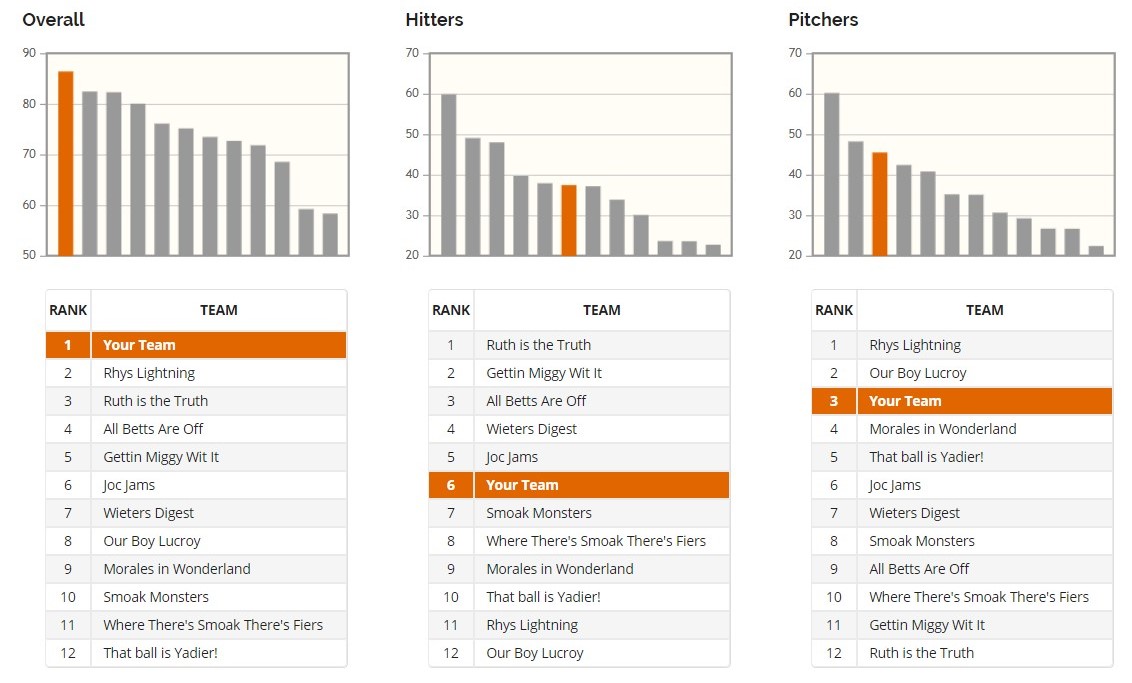
2020 RP Targets
This season, once I reach the second half of the draft and start filling my rotation and bullpen, these are some late-round relievers I'm targeting in my personal order of attack:
Seth Lugo, NYM - 256 ADP (2020 ATC Proj: 72 IP, 4 W, 3.14 ERA, 1.07 WHIP, 83 K, 4 SV)
As a reliever, he now owns a 2.52 ERA and 10.04 K/9 over 178 career IP. Last season was the first in which he remained in the bullpen for the whole year, and it paid dividends for fantasy owners like me. 80 IP, 104 K, 2.70 ERA, and 0.90 WHIP which was good for RP12 in fantasy. Give me those high innings and K along with the elite ratios.
Ryan Pressly, HOU - 292 ADP (61 IP, 3 W, 3.06 ERA, 1.08 WHIP, 78 K, 6 SV)
Yes, he is amazing.
Diego Castillo, TB - 364 ADP (64 IP, 4 W, 3.31 ERA, 1.15 WHIP, 76 K, 8 SV)
In 2019, Castillo seemed to take a small step backward from the promising rookie campaign as his ERA and WHIP rose to 3.41 and 1.24 respectively. But if you remove the 7.1 innings when he operated as an "opener", his ERA was actually just 3.08. With those opener innings erased, Castillo was the only reliever in baseball with at least a 50 GB% and double-digit K/9, with an ERA under 4.00 and HR/9 under 1.00. He also got even better as the year wore on. After the All-Star break, he posted a 2.88 ERA (2.89 FIP) with a massive 11.27 K/9, and best-of-all lowered his walk rate to just 7%. He checks all the boxes. He has the strikeout upside, he prevents line drives, he limits hard-hit fly balls, and he's still only 26 years old.
Drew Pomeranz, SD - 342 ADP (62 IP, 2 W, 3.50 ERA, 1.18 WHIP, 76 K. 5 SV)
Finishing the season as a reliever, Pomeranz threw 28.2 IP with a 1.88 ERA, 15.70 K/9, and a 51.1 GB%. He held opposing hitters to a .165 BA and boasted a 1.67 xFIP. The K/9 was good for third-highest among RP with 20+ IP, and only Brandon Workman also had a top-30 K/9, GB% above 50%, and an ERA below 2.00. Yes, it is a small sample size, but Pomeranz would not be the first SP to flourish after a move to the pen. The upside is yyyyuuuuuggggeeee.
Chad Green, NYY - 364 ADP (67 IP, 4 W, 3.62 ERA, 1.11 WHIP, 90 K, 1 SV)
There are plenty of pleasantries to take away from Green's 2019 season. The first is the strikeouts remained constant. His 12.78 K/9 fell smack dab in the middle of his 2017 and 2018 totals. His O-Swing%, Contact%, and SwStr% were also all on par. The second positive is Green has remained healthy for three straight seasons and his velocity remains intact. The third positive was a very strong second half of the season which bodes well for his 2020 outlook. Green started the season just about as bad as one could, allowing 14 ER in his first 7.2 IP. But the Yankees got creative, even used him as an opener, and he responded in a great way. After the All-Star break, Green allowed just a 2.89 ERA, 0.96 WHIP, .176 BAA, 0.72 HR/9, and the BABIP dropped drastically. He is the Robin to my Seth Lugo Batman.
Ross Stripling, LAD - 334 ADP (93 IP, 6 W, 3.75 ERA, 1.20 WHIP, 93 K, 0 SV)
Last year it was Julio Urias as my main "Swingman" that could get me multi-inning relief outings with a surplus of strikeouts while still giving me great ratios. This year Stripling is my guy. I don't hate that he will sprinkle in some starts throughout the year either to help the team's W and K numbers.
Emilio Pagan, SD - 273 ADP (65 IP, 3 W, 3.31 ERA, 1.05 WHIP, 82 K, 3 SV)
Much like Taylor Rogers, Emilio Pagan enjoyed a career-year in 2019 which resulted in earning the closer role. His 12.34 K/9 was a personal best, as was his GB%. Also in tune with Taylor Rogers, Pagan increased his slider usage which resulted in a 7% increase in O-Swing%, 5% decrease in Contact%, and raised his SwStr% to a very impressive 17.6%. His fastball was equally impressive as it gained a slight uptick in velo which led the way with a 42.1 K%. Obviously, for 2020 he is a cemented setup man after his trade to the Padres, but the skills will certainly still play.
Aaron Bummer, CWS - 399 ADP (62 IP, 2 W, 3.20 ERA, 1.26 WHIP, 60 K, 2 SV)
Huge ground-ball guy, which I love, and his 2019 ratios were just fantastic. If he can increase the strikeout rates back to even the 9.95 from 2018, Bummer will be a huge fantasy asset in 2020.
Weekly Leagues
It makes sense that the Bullpen Method is much easier to pull off in daily roster leagues, where you can change your lineup every day. This means you can maximize your SP starts and your reliever innings by swapping RP daily to avoid off-days. In weekly roster leagues, it certainly gets more challenging, but I also love the complexity it adds. Each week, you get to analyze and determine your "Ratio," a.k.a. how many SP and how many RP you will utilize in that week's starting lineup. My baseline is usually 4:5, especially if I have a two-start SP but it will fluctuate week-to-week based on pitchers' schedules and my place in the standings.
You aren't going to want to start a one-start SP on the road versus the Yankees so why not replace him with four clean innings from one of your stud relievers instead? That same week you could have an SP at Coors too, now you might be looking at a 3:6 ratio. Likewise, if you have five SP with either two-start weeks or great match-ups, go 5:4 and do some catch-up in W and K. Your fantasy-managerial skills will be tested, but your Sunday nights/Monday mornings will certainly be more exciting and/or filled with anxiety. Bottom line this method can work in any type of league, as long as you are being proactive.
More 2020 Fantasy Baseball Advice
 RADIO
RADIO





















